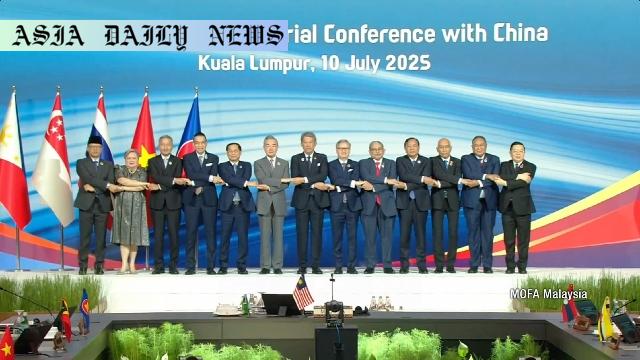Economic Ties: China and ASEAN seek stronger bonds amidst US tariffs.

Introduction to the Meeting Between China and ASEAN
On Thursday, foreign ministers from China and the Association of Southeast Asian Nations (ASEAN) convened in Kuala Lumpur, Malaysia, to discuss fortifying their economic collaboration amid mounting global economic challenges. The meeting occurred as Malaysia hosted a series of ASEAN-focused gatherings under its role as the bloc’s chair. Against the backdrop of rising US tariffs, particularly under the administration of President Donald Trump, this dialogue underscored both concerns and opportunities for fostering regional economic integration.
The Progress of a New Free Trade Framework
One of the key outcomes of previous negotiations was the completion of the so-called 3.0 version of the ASEAN-China Free Trade Area agreement in May. This significant milestone reflects the proactive efforts by both sides to boost trade liberalization, streamline logistical barriers, and foster smoother economic coordination across borders. Chinese Foreign Minister Wang Yi reiterated the importance of these strengthened ties, emphasizing China’s commitment to closer cooperation with ASEAN. Wang indicated that collaboration amidst external economic adversity could pave the way for a fairer, multipolar global economy, moving away from domination by unilateral measures like US-imposed tariffs.
Concerns Over US Tariffs and the Global Economy
US tariff policies have placed notable stress on various economies, including those in Southeast Asia. Malaysian Foreign Minister Mohamad Hasan highlighted the risks posed by protectionist measures, urging vigilance to preserve an open, fair, and rules-based trading system. A shared sentiment among ASEAN leaders reflects the concern that these tariffs could disrupt interconnected supply chains vital to ASEAN nations’ economic growth. Both Malaysia and China agree on the importance of collaborative problem-solving to counter such challenges effectively.
The Risks of Dependence on China’s Economy
However, the enthusiasm for stronger ASEAN-China economic ties is not without reservations. During the deliberations, officials reflected on the potential drawbacks of overreliance on the Chinese economy. Changes within China’s economic landscape, including slower growth rates or global headwinds, could pose risks for weaker or heavily tied ASEAN economies. This concern underscores the need for diversified trade partnerships and contingency strategies within the ASEAN bloc to mitigate economic exposure.
A Vision for Equitable Globalization
Minister Wang also highlighted the broader vision of an equitable, inclusive, and just economic globalization framework, where global powers coexist under an orderly multipolar system. ASEAN’s active pursuit of collaboration with China mirrors its aim to capitalize on regional synergies while balancing risks. The alignment of shared goals for economic integration has fueled optimism for ASEAN’s future. However, further dialogues are essential to address nuanced concerns and ensure sustainable progress for all member countries.
Future Implications for ASEAN and Its Global Presence
The strengthening of economic ties between China and ASEAN may redefine the geopolitical and economic balance of power in the Asia-Pacific region. As ASEAN countries continue to navigate the complexities of global trade, their partnerships with strategic powers like China and other major economies will likely determine their ability to sustainably advance common objectives. On a broader level, these efforts reflect a strong commitment to remain resilient amid geopolitical uncertainties, actively shaping a more interconnected region aligned with economic fairness and shared success.
Commentary
The Importance of ASEAN-China Economic Collaboration
The recent discussions between China and ASEAN about bolstering their economic partnership couldn’t have come at a timelier moment. With escalating challenges in global trade, particularly those rooted in US tariff measures, it is evident that regional partnerships are becoming increasingly crucial. ASEAN nations represent a dynamic and rapidly growing region, and their ability to collaborate with a global powerhouse like China brings significant opportunities for shared prosperity. The completion of the 3.0 free trade area agreement reflects mutual commitment and progress, setting an important precedent for future initiatives.
Addressing the Challenges of Geopolitical Influences
While the benefits of ASEAN-China collaboration are apparent, the meeting also underscores important lessons in balancing economic dependency. China’s economic influence has grown exponentially over the last two decades, presenting both opportunities and potential vulnerabilities for ASEAN states. The cautious sentiments voiced by some officials regarding an over-reliance on China should be noted. As global trade becomes increasingly interlinked, maintaining diverse partnerships will be key to mitigating risks and safeguarding economic stability within the region.
A More Inclusive and Fair Global Economy
Chinese Foreign Minister Wang Yi’s broader call for a more inclusive and balanced world order challenges existing norms underpinned by unilateral economic decisions, such as US tariff measures. ASEAN’s alignment with such principles highlights not only its priorities for fair trade but also its potential role as a champion for equitable globalization. By presenting a united front, ASEAN nations can strengthen their voice on the global stage and drive collective solutions for persistent challenges in trade and diplomacy.
Looking Ahead to Regional Resilience and Unity
In conclusion, the discussions between ASEAN and China reflect a broader trend of regional resilience and collective problem-solving in an increasingly complex global economic environment. As leaders find ways to foster strategic partnerships while managing risk, they are not only shaping the future of Asia-Pacific trade but also providing a blueprint for how regions can thrive amidst global uncertainties. For ASEAN, the journey ahead lies in fostering balanced growth, inclusivity, and innovation while remaining vigilant to both opportunities and potential pitfalls.


